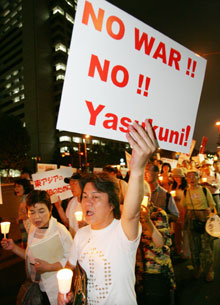Top News
Koizumi to visit shrine on August 15
(Reuters)
Updated: 2006-08-15 06:42
 |
Large Medium Small |
Japanese Prime Minister Junichiro Koizumi will make a pilgrimage later on Tuesday to Tokyo's Yasukuni Shrine for war dead, considered to be a symbol of Japan's past militarism, an aide said.
 A protester holding a placard shouts slogans during a candlelight march in Tokyo August 11, 2006 demanding Japanese Prime Minister Junichiro Koizumi to stop visiting the Yasukuni Shrine. [Reuters] |
Koizumi, who plans to step down in September, had been widely expected to visit the shrine on the August 15 anniversary of Japan's surrender in 1945, an emotive date in much of Asia.
Tokyo's ties with Beijing and Seoul have already deteriorated to their worst state in decades, in part because of Koizumi's past pilgrimages to the shrine.
While the United States has not publicly complained, experts say Washington is worried about Japan's growing isolation in the region and its deteriorating ties with rival China in particular.
The shrine played a central role in the wartime state religion that helped mobilize the nation to fight in the name of a divine emperor.
Koizumi, who is set to leave office after more than five years, promised during his campaign to become ruling party chief in 2001 that he would visit the shrine on the August 15 anniversary.
He has visited every year since, but never on that date.
Koizumi says he goes to the shrine to pray for peace and honor those who sacrificed their lives for their country.
Critics argue his visits reflect Japan's failure to face up to its wartime past, including atrocities committed in Asia.
Japanese public opinion is divided on whether the prime minister should make pilgrimages to Yasukuni and the ruling Liberal Democratic Party (LDP) is itself split on the issue.
The shrine considers 14 wartime leaders convicted by an Allied tribunal as Class A war criminals to be "martyrs."
A museum on its grounds depicts the Pacific war as one Japan was forced to fight in self-defense and has been criticized for ignoring atrocities committed by Japanese.
HEATED DEBATE
Visits by Japanese leaders to the shrine have become a focus of the competition to succeed Koizumi in a ruling party leadership election on September 20.
Many Japanese business executives, concerned that the diplomatic chill could hurt vital economic ties with China, have made clear they want the next prime minister to halt the visits.
Chief Cabinet Secretary Shinzo Abe -- seen as increasingly certain to succeed Koizumi -- has defended the prime minister's pilgrimages and went there himself this time last year.
Media have said Abe, 51, also paid a secret visit in April.
The soft-spoken political blue-blood, a security hawk has declined to say whether he would go there if he becomes prime minister.
One lagging contender, Finance Minister Sadakazu Tanigaki, has promised to refrain from going there if he becomes premier.